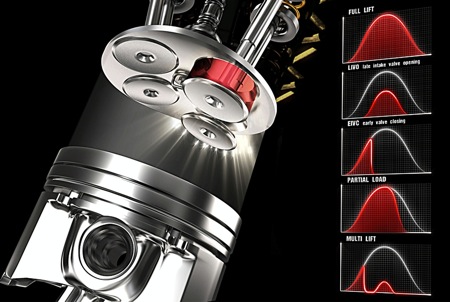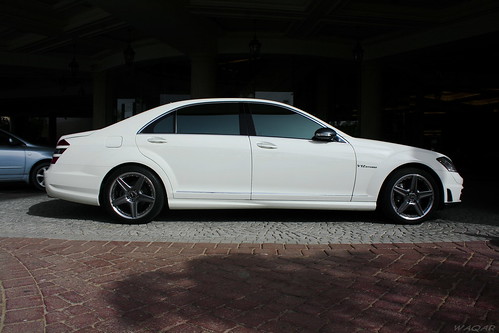So, I don't understand computers, as far as I'm concerned they're powered by witchcraft. But as ch00kz pointed out they did help with the automobile. Instantly the ECU comes to mind and so did the automatic transmission and I immediately thought negatively. So after a days worth of positive thinking this is the best I could come up with.
10) Stop-Start Systems
These systems started taking serious interest after the dawn of the hybrid movement. Hybrids depend on this technology but more and more non-hybrids are taking on this technology so as to improve fuel mileage without adding super complex hybrid systems. It really is simple and works best with manual transmissions. When a driver comes to a stop for an extended period [traffic], the engine is still running and burning fuel and since it is going no where, the car develops 0 mpg. The simple answer to this is to just switch off your engine and restart when ready; but its not so simple. When your engine shuts off so does a lot of other things, like brake assist, air conditioning and power steering. What companies are doing now is to make these ancillary systems run independent of the engine enabling them to work when the engine is off [this also makes the engine more efficient]. With this switch, the ECU [engine control unit] is programmed to shut off the engine when the car is at 0mph once the driver is in neutral and has released the clutch. Whenever the driver depresses the clutch to take action the ECU starts back the engine. In practice it seems like an annoyance so fortunately most companies offer the ability to turn this system off.
9) Anti-Lock Braking System [ABS] and other driver aids
Now most cars have ABS and fact is most of us will either never experience it or know when its taking place. ABS really is a system that regulates the brakes to ensure people don't go sliding all over the place and killing themselves. The other systems pretty much do the same thing or similar by regulating both the brakes and throttle. ABS started out life on airplanes and then found its way on to cars as they got faster and needed to slow down just as fast. Most cars have the full ABS, stability control and traction control package and sooner or later they will all be mandatory, and just like stop-start systems they can be turned off [except ABS] if they are annoying
8) Displacement on Demand

This bit of tech comes from America after being heavily criticized for having huge engines with low fuel economy. To have the best of both worlds Displacement on Demand was implemented in both GMs and Chrysler's V8 engine line-up. It works by the ECU detecting what kind of power is needed from the engine. After calculating this, the ECU decides how much cylinders in the engine are needed for that power requirement and shuts down as much as half of the engine to accommodate the power requirement. Because the cylinders still remain in motion despite being shut off from fuel, transitions between cylinder activations are smooth and unnoticeable. Because it is also such a mechanically complex system, it only makes sense for use on engines with more than 8 cylinders. Also because of its newness, performance engines also ignore this technology due to the high stress levels found in their engines. Both Cadillac and Jeep featured this technology on their 16 cylinder engined concepts, the Cadillac Sixteen [engine pictured] and Jeep Hurricane which could run on 4, 8, or 16 cylinders [Jeep Hurricane could run on 12 also]
7) Computer Simulations
I don't like seeing a really expensive and cool car being crashed, but in reality at least one model needs to be sacrificed to test its safety in a crash. With accurate to the micron computer crash simulations, crashes can be analysed over and over to discover weak points and improve on them without unnecessarily crashing cars repeatedly into a wall. It also saves constructors money seeing that they only need to crash one car to pass each safety test instead of crashing numerous for research.
6) Kinetic Energy Recovery System [KERS]
This is another tech taken from hybrids and manipulated to work in racing. It works by taking energy that is loss under braking [Kinetic Energy] and stores this energy [Recovery] in either a flywheel [a constantly rotating mass] or in batteries [which what hybrids do]. After being stored, this energy can then be released at the push of a button to use as an extra boost. Of course computers control when the loss energy is gathered and stored, and in the case of racing, regulate how many times it can be used. Outside of hybrids only Porsche and Ferrari [whose system is pictured] are developing this for road use.
5) Active Suspension
This is a not so old technology that has remained hidden for years. What it does is to use computers to automatically adjust the suspension firmness and height. Semi active systems adjust these to predetermined settings while true active suspensions can adjust to an infinite amount of settings based on readings taken from different sensors. By infinitely adjusting suspension settings, the car can ride smoothly and not experience any hops, rolls or bumps which not only increases passenger comfort but also ensures that all 4 wheels keep in contact with the ground. By also adjusting the ride height the car can be lowered to improve aerodynamics and be raised to clear bumps. Williams and Lotus pioneered the technology to such a high degree in Formula 1 that it was soon banned for giving too much of an advantage. Only a select few high end vehicles use this tech for comfort reasons [think big plushy benzs] while other cars use them to clear speed bumps [think Ferrari Enzo]
4) Active Aerodynamics
Before I go any further, a spoiler is a flat panel which is tilted to produce downforce, the problem is that too much downforce increases wind resistance and lowers high speed acceleration but at the same time increases road grip and vice-versa. To take advantage of this some cars utilize a computer controlled spoiler that can tilt to either produce alot of or a little downforce. In some cars [Bugatti Veyron and Mercedes Benz SLR] the spoiler can be tilted at such a steep angle that it actually slows down the car and assists braking. Porsche has been noted for including active aerodynamics on almost all of its vehicles, whereas Mercedes is noted for first using it as a brake as far back in the 50s [where driver would pull a big lever to open a huge flap] BMW has however taken active aerodynamics the furthest with its GINA concept which is able to reconfigure the entire shape of the car to the required aerodynamic profile.
Active aerodynamics also affect cooling. Because cooling vents on a car actually cause aerodynamic drag, some cars actually can close off these vents when not needed to improve aerodynamics.
3) Actuated Valves
This is a really new yet clever piece of tech that is only being used by BMW and Fiat, in their road cars and being researched and developed in others. This takes Variable Valve Timing [VVT] and changes it from a 2 stage system to an almost infinitely adjustable system by controlling the valves that let in air and let out exhaust by electric actuators rather than camshafts [a rotating rod with lobes that push open the valves at regular intervals]. VVT gives the engine 2 characteristics, powerful and economic and in most cars the transition is abrupt and sometimes annoying. With actuated valves, the engine can have various different characteristics depending on the amount of power needed. In concept it is like displacement on demand except it can be used in a wide array of engines.
2) Variable Compression Ratio
This is a top secret new technology that is very promising for the future of the internal combustion engine. By altering the compression ratio of a car's engine, its characteristics can be altered enabling it to be either very fuel efficient, very powerful or to run on different fuels. Only 3 companies are publicly developing this type of engine; Prodrive [VCR Go] Mercedes-Benz [Dies Otto] and Lotus [Omnivore]. Each are unique yet all still very top secret in how they work in detail, but from what I'm getting, only the roof of the engine is altered to vary the compression ratio.
1) Mercedes-Benz S Class
Mercedes-Benz has always had huge shoes to fill especially since they were responsible for the first car. To prove that the first car was not a buck-ups Mercedes-Benz has pretty much been pioneers when it comes to automotive technology ever since. The S class has always been Mercedes's test bed for technology and it is commonly known that the car of the future will have features that the S class has today. Not only has the S class benefited from all the technologies on this in one shape or the other, in some cases it was the first to feature them. I could go on for years about the amount of tech stuffed into an S class, so instead here is a video of some of its stuff.













No comments:
Post a Comment